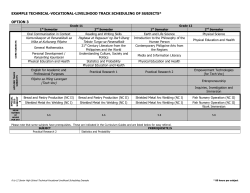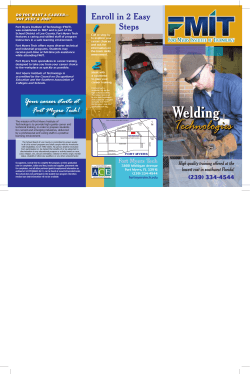
WELDING PROCESSES
Welding Methods and Procedures 1. 2. 3. 4. 5. 6. Arc Welding Resistance Welding Oxyfuel Gas Welding Other Fusion Welding Processes Weld Quality Design Considerations in Welding ©2007 John Wiley & Sons, Inc. M P Groover, Fundamentals of Modern Manufacturing 3/e Two Categories of Welding Processes Fusion welding - coalescence is accomplished by melting the two parts to be joined, in some cases adding filler metal to the joint Examples: arc welding, resistance spot welding, oxyfuel gas welding Solid state welding - heat and/or pressure are used to achieve coalescence, but no melting of base metals occurs and no filler metal is added Examples: forge welding, diffusion welding, friction welding ©2007 John Wiley & Sons, Inc. M P Groover, Fundamentals of Modern Manufacturing 3/e Arc Welding (AW) A fusion welding process in which coalescence of the metals is achieved by the heat from an electric arc between an electrode and the work Electric energy from the arc produces temperatures ~ 10,000 F (5500 C), hot enough to melt any metal Most AW processes add filler metal to increase volume and strength of weld joint ©2007 John Wiley & Sons, Inc. M P Groover, Fundamentals of Modern Manufacturing 3/e Arc Welding A pool of molten metal is formed near electrode tip, and as electrode is moved along joint, molten weld pool solidifies in its wake Figure 31.1 Basic configuration of an arc welding process. ©2007 John Wiley & Sons, Inc. M P Groover, Fundamentals of Modern Manufacturing 3/e Power Source in Arc Welding Direct current (DC) vs. Alternating current (AC) AC machines less expensive to purchase and operate, but generally restricted to ferrous metals DC equipment can be used on all metals and is generally noted for better arc control ©2007 John Wiley & Sons, Inc. M P Groover, Fundamentals of Modern Manufacturing 3/e Shielded Metal Arc Welding Figure 31.2 Shielded metal arc welding (stick welding) performed by a (human) welder (photo courtesy of Hobart Brothers Co.). ©2007 John Wiley & Sons, Inc. M P Groover, Fundamentals of Modern Manufacturing 3/e Gas Tungsten Arc Welding (GTAW) Uses a nonconsumable tungsten electrode and an inert gas for arc shielding Melting point of tungsten = 3410C (6170F) A.k.a. Tungsten Inert Gas (TIG) welding In Europe, called "WIG welding" Used with or without a filler metal When filler metal used, it is added to weld pool from separate rod or wire Applications: aluminum and stainless steel most common ©2007 John Wiley & Sons, Inc. M P Groover, Fundamentals of Modern Manufacturing 3/e Gas Tungsten Arc Welding Figure 31.9 Gas tungsten arc welding. ©2007 John Wiley & Sons, Inc. M P Groover, Fundamentals of Modern Manufacturing 3/e Resistance Welding (RW) A group of fusion welding processes that use a combination of heat and pressure to accomplish coalescence Heat generated by electrical resistance to current flow at junction to be welded Principal RW process is resistance spot welding (RSW) ©2007 John Wiley & Sons, Inc. M P Groover, Fundamentals of Modern Manufacturing 3/e Resistance Welding Figure 31.12 Resistance welding, showing the components in spot welding, the main process in the RW group. ©2007 John Wiley & Sons, Inc. M P Groover, Fundamentals of Modern Manufacturing 3/e Components in Resistance Spot Welding Parts to be welded (usually sheet metal) Two opposing electrodes Means of applying pressure to squeeze parts between electrodes Power supply from which a controlled current can be applied for a specified time duration ©2007 John Wiley & Sons, Inc. M P Groover, Fundamentals of Modern Manufacturing 3/e Resistance Spot Welding (RSW) Resistance welding process in which fusion of faying surfaces of a lap joint is achieved at one location by opposing electrodes Used to join sheet metal parts using a series of spot welds Widely used in mass production of automobiles, appliances, metal furniture, and other products made of sheet metal Typical car body has ~ 10,000 spot welds Annual production of automobiles in the world is measured in tens of millions of units ©2007 John Wiley & Sons, Inc. M P Groover, Fundamentals of Modern Manufacturing 3/e Spot Welding Cycle Figure 31.13 (a) Spot welding cycle, (b) plot of squeezing force & current in cycle (1) parts inserted between electrodes, (2) electrodes close, force applied, (3) current on, (4) current off, (5) electrodes opened. ©2007 John Wiley & Sons, Inc. M P Groover, Fundamentals of Modern Manufacturing 3/e Weld Quality Concerned with obtaining an acceptable weld joint that is strong and absent of defects, and the methods of inspecting and testing the joint to assure its quality Topics: Welding defects Inspection and testing methods ©2007 John Wiley & Sons, Inc. M P Groover, Fundamentals of Modern Manufacturing 3/e Welding Defects Cracks Cavities Imperfect shape or unacceptable contour Incomplete fusion Miscellaneous defects ©2007 John Wiley & Sons, Inc. M P Groover, Fundamentals of Modern Manufacturing 3/e Welding Cracks Fracture-type interruptions either in weld or in base metal adjacent to weld Serious defect because it is a discontinuity in the metal that significantly reduces strength Caused by embrittlement or low ductility of weld and/or base metal combined with high restraint during contraction In general, this defect must be repaired ©2007 John Wiley & Sons, Inc. M P Groover, Fundamentals of Modern Manufacturing 3/e Welding Cracks Figure 31.31 Various forms of welding cracks. ©2007 John Wiley & Sons, Inc. M P Groover, Fundamentals of Modern Manufacturing 3/e Cavities Two defect types, similar to defects found in castings: 1. Porosity - small voids in weld metal formed by gases entrapped during solidification Caused by inclusion of atmospheric gases, sulfur in weld metal, or surface contaminants 2. Shrinkage voids - cavities formed by shrinkage during solidification ©2007 John Wiley & Sons, Inc. M P Groover, Fundamentals of Modern Manufacturing 3/e Incomplete Fusion Also known as lack of fusion, it is simply a weld bead in which fusion has not occurred throughout entire cross section of joint Figure 31.32 Several forms of incomplete fusion. ©2007 John Wiley & Sons, Inc. M P Groover, Fundamentals of Modern Manufacturing 3/e Weld Profile in AW Weld joint should have a certain desired profile to maximize strength and avoid incomplete fusion and lack of penetration Figure 31.33 (a) Desired weld profile for single V-groove weld joint. ©2007 John Wiley & Sons, Inc. M P Groover, Fundamentals of Modern Manufacturing 3/e Weld Defects in AW Figure 31.33 Same joint but with several weld defects: (b) undercut, in which a portion of the base metal part is melted away; (c) underfill, a depression in the weld below the level of the adjacent base metal surface; and (d) overlap, in which the weld metal spills beyond the joint onto the surface of the base part but no fusion occurs. ©2007 John Wiley & Sons, Inc. M P Groover, Fundamentals of Modern Manufacturing 3/e Inspection and Testing Methods Visual inspection Nondestructive evaluation Destructive testing ©2007 John Wiley & Sons, Inc. M P Groover, Fundamentals of Modern Manufacturing 3/e Visual Inspection Most widely used welding inspection method Human inspector visually examines for: Conformance to dimensions Warpage Cracks, cavities, incomplete fusion, and other surface defects Limitations: Only surface defects are detectable Welding inspector must also determine if additional tests are warranted ©2007 John Wiley & Sons, Inc. M P Groover, Fundamentals of Modern Manufacturing 3/e Nondestructive Evaluation (NDE) Tests Ultrasonic testing - high frequency sound waves directed through specimen - cracks, inclusions are detected by loss in sound transmission Radiographic testing - x-rays or gamma radiation provide photograph of internal flaws Dye-penetrant and fluorescent-penetrant tests - methods for detecting small cracks and cavities that are open at surface Magnetic particle testing – iron filings sprinkled on surface reveal subsurface defects by distorting magnetic field in part ©2007 John Wiley & Sons, Inc. M P Groover, Fundamentals of Modern Manufacturing 3/e Destructive Testing Tests in which weld is destroyed either during testing or to prepare test specimen Mechanical tests - purpose is similar to conventional testing methods such as tensile tests, shear tests, etc Metallurgical tests - preparation of metallurgical specimens (e.g., photomicrographs) of weldment to examine metallic structure, defects, extent and condition of heat affected zone, and similar phenomena ©2007 John Wiley & Sons, Inc. M P Groover, Fundamentals of Modern Manufacturing 3/e
© Copyright 2025









